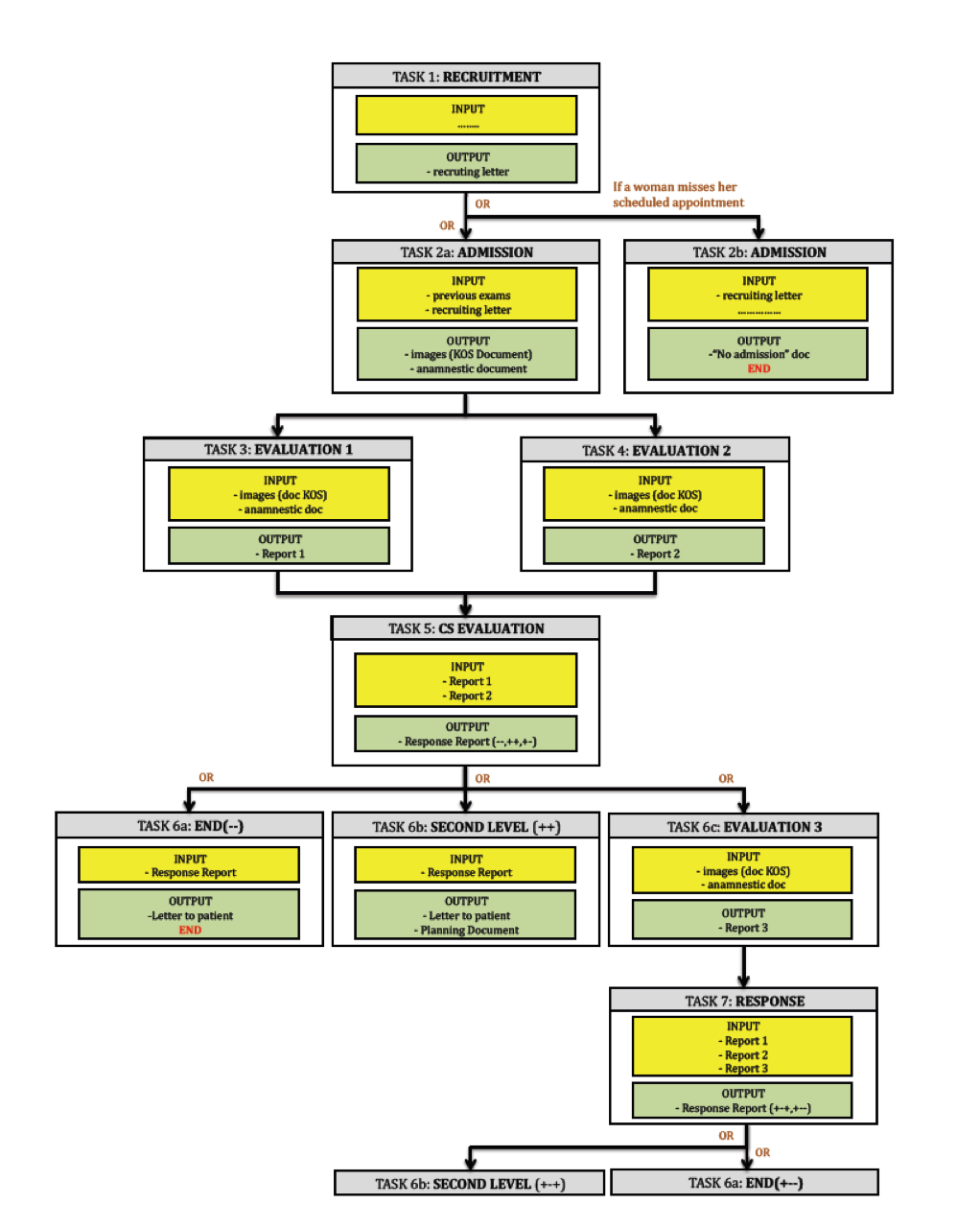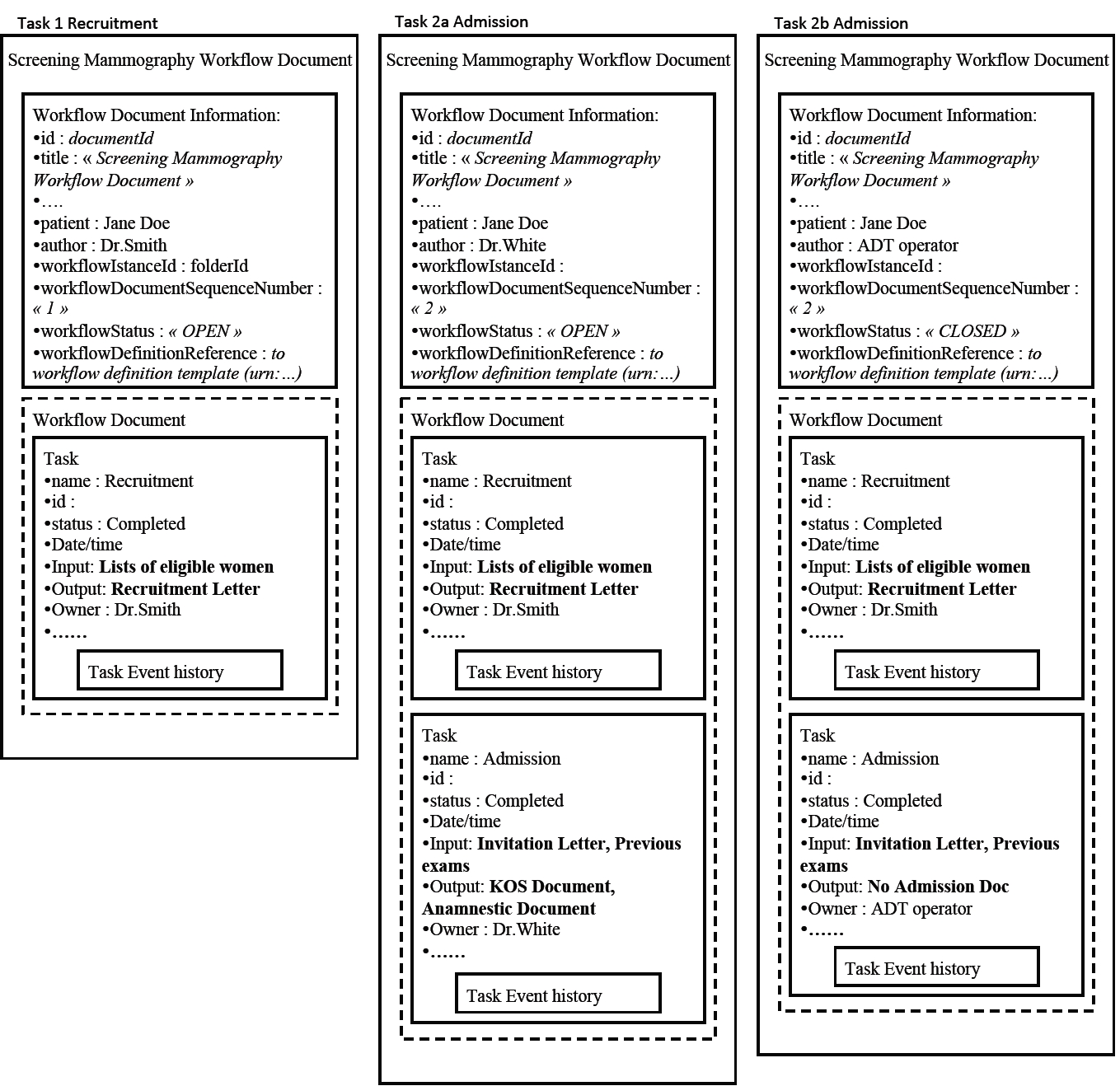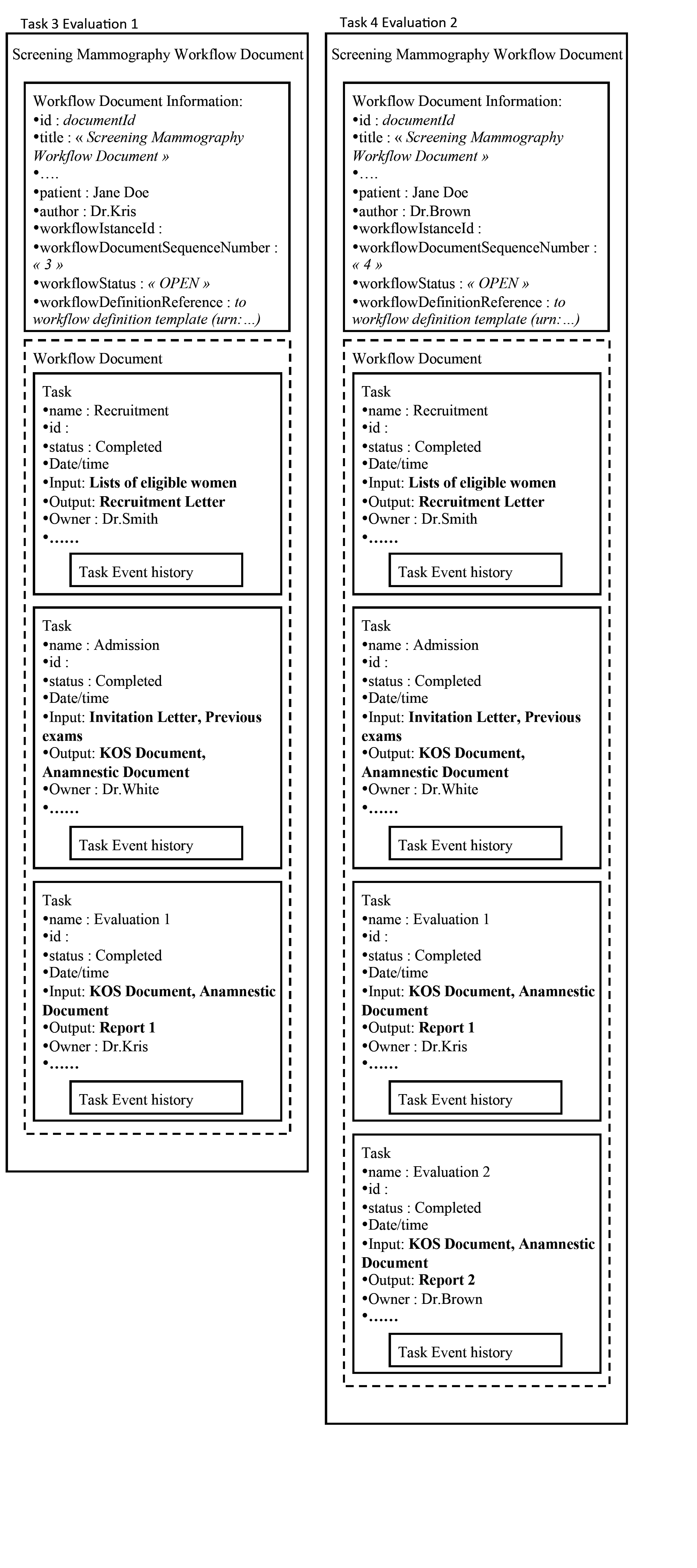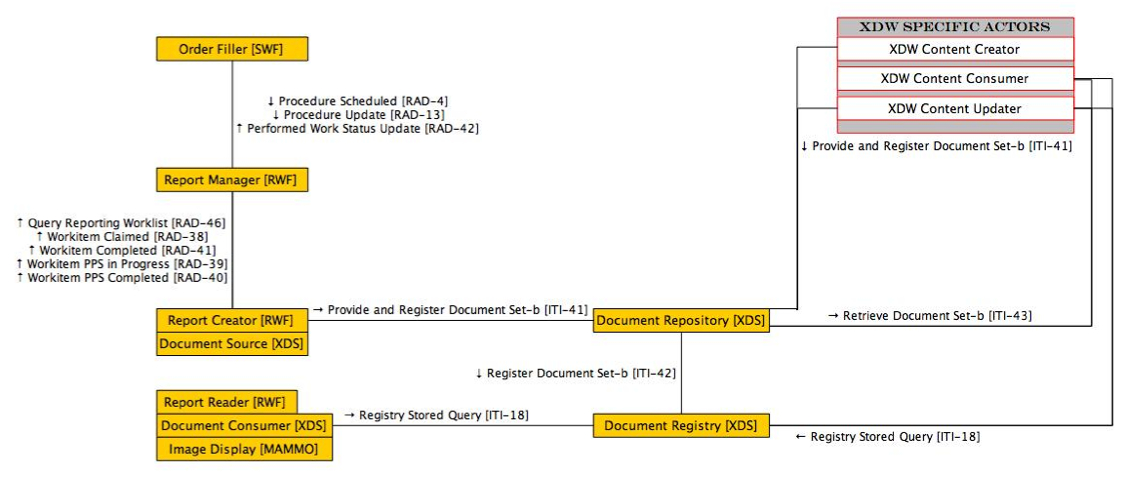Cross Enterprise Screening Mammography Workflow Definition Whitepaper - Detailed Proposal
1. Proposed Work Item: Cross Enterprise Screening Mammography Workflow Definition Whitepaper
- Proposal Editor: Roberto Silverio, Claudio Saccavini, Nadia Racanello, Arianna Cocchiglia, Francesca Vanzo
- Profile Editor: Arianna Cocchiglia, Francesca Vanzo, Luca Zalunardo
- Domain: Radiology
Summary
Given that breast cancer has increased significantly in all occidental countries, the need to manage and to provide standard-oriented guidelines on its screening methods has become crucial also because of the variability of the approaches across all enterprises and manufacturers. XDW profile allows to track and manage all the tasks concerned in the screening process (multi-blind reading evaluation,...) also extending future requirements as well as XDS profile provides the multi enterprise exchange of useful clinical document and DICOM study related information. The Cross Enterprise Screening Mammography could be the means by which it will be possible to perform an effective and an efficient screening process, taking into account standards and interoperability issues through the optimized gathering of the core set of principles on screening itself.
Mammography screening programs are spreading worldwide as well as the request of Information System to manage all the tasks: women recruitment with personal invitation system, image acquisition and, of course, screening response evaluation processes. Facing the commonly recommended procedures to be adopted in the early-stage detection of the breast cancer with real-world and standard-based healthcare interoperability scenarios, will lead to reach significant benefits and to avoid the lack of information in one of the most relevant screening program of our time.
2. The Problem
The Breast Cancer, in all occidental countries, has reached a range of incidence as wide as it may represent a real social disease. Current knowledge does not allow implementing primary prevention measures to remove the causal factors. It has instead been demonstrated, the efficacy of secondary prevention, which represents the essential part of the contemporary care in this disease. Several studies have shown that, by subjecting a female population in the range of age at increased risk of breast cancer, to a periodic mammography exam, mortality from this cancer decreases by 30-50% due to the increased effectiveness of the treatment applied early stage of disease. For this reason, in the last 20 years, it has been given particular importance to the possibility to control the breast cancer mortality with a systematic early diagnosis. This result has evolved in the activation of mammography screening programs of high quality, aimed at women in age groups at highest risk, with priority given to women between the ages of 50 and 69 years.
In the last ten years all the larger states have started screening programs for breast cancer (U.S., Canada, UK, Australia, Singapore), hence the need to manage and standardize this clinical process has become crucial.
Screening programs are clinical trials that involve different clinical information systems. In the Radiology domain of IHE, the diagnostic phases of image acquisition and exam are already standardized (MAW Mammography Acquisition Workflow based on IHE Radiology Scheduled Workflow Integration Profile) but lack: the integration of these phases in the total screening process, the possibility to split these phases in more enterprises and the definition of the screening process workflow management.
It is required an instrument to delineate at high-level a rigorous definition of the process and at lower-level to focus on the patient to keep track of the screening visit event, related documents produced in this process. This instrument allows easy exchange of information between different actors so that in case of disease the process of screening and care are integrated.
Discussion: This proposal arises from the necessity to manage the process of breast screening in Radiology area. It proposes a more general approach which allows to integrate the Radiology mammography exam in an complex scenarios and to manage the breast screening workflow that relies the clinical documents in many different care areas. The value statement of this proposal is:
- the standardization of the workflow’s management process and the associated workflow tracking structure linked with the clinical process of the breast screening
- the creation of an instrument able to respond at the present needs and possibly to extend to future requirements
This profile proposal benefits Radiology domain managing a complex workflow. It increases the consistency of workflow interoperability and the skill to solve the requests of the various care areas. It will provide a standard solution to manage this clinical process and avoid that different competing solutions are developed in the different areas. It is necessary to create a Radiology Profile in this field. This profile proposal connects two domains, ITI and RAD, leading a complete management of a Screening service. In fact, with the support of the first domain and, in particular, of the XDW profile, it increases the consistency of workflow interoperability and it allows to share and update all events of the screening process between different enterprises. The RAD domain, instead, has the duty to define the specific workflow. The workflow definition can be understood and executed among the participating systems/applications. The orchestration of a specific workflow allows the workflow participants to share a common understanding of the specific tasks, the dependencies between these tasks, and a number of rules that control the workflow execution and leads the interoperability between different information systems. Execution details are conveyed through the XDW Workflow Document.
3. Key Use Case: Screening process management
The use case contributes to better manage the mammographic screening program taking into account possible pathways from the selection of the candidates in order to pre-schedule the appointments, to the actions to be taken based on the results.
This use case is based on the Italian program screening for breast cancer. Every step can be handled by using the XDW profile that can deal with the processes with a central information system (CS) and the hospital information systems in charge to update the Workflow Document for each task.
The process is composed of the following tasks:
At first, the CS generates a list of all women in the risk range of age based on the anagraphical systems (primary target age group), past exams,... The CS checks the list, schedules all the appointments for the different enterprises, matching also addresses and range of different locations criteria. At this time the first step in the workflow process for a patient is the invite to do the exam: the CS composes and sends out the recruiting (or invitation) letters containing place of the facility, date and time of the visit and information (describing the screening and answering to common questions and concerns women have about mammography). Invitation letter represents the output of the Workflow Document as shown in the image below [Task 1 in the figure 3-1]. Every day the CS compiles the list of scheduled appointments and sends it to the different enterprises.
The second task in the workflow is the visit [Task 2a in the figure 3-1]. Each recruited woman, who comes to the hospital, is admitted and all previous examinations and the recruiting letter are collected as input of this second task in the Workflow Document. (If a woman misses her scheduled appointment, the entire path ends with a “No admission” document, which is the Workflow Document’s final output in this case and a notification is sent to the CS which can reschedule the exam [Task 2b in the figure 3-1]). The visit takes place and KOS Document (from Mammography Acquisition Workflow and Mammography Image Profiles) as well as the anamnestic document is available and they represent the output documents of this task. Once the CS is aware of the completion of exams, it compiles the worklist and sends it to the radiologist.
Every exam must have a double evaluation. So two radiologists proceed in modality “double blind” to check the exam and to produce the report with the result (positive or negative). So in the both two cases we have two evaluation tasks [Task 3 and 4 in the figure 3-1] that will have as input the KOS document, to retrieve the images, and the anamnestic document as output of the report.
The fifth task in the process is the evaluation by the CS of the two reports:
If both reports are negative the CS sends a letter including the negative result to the patient and the use case ends [Task 6a in the figure 3-1].
If both reports are positive the CS will compose an “Alert” letter including instructions and the second level of the screening process starts [Task 6b in the figure 3-1].
If the two results are discordant (one positive, one negative) the CS reschedules one blind reading in another worklist for a third evaluation. In this case we have another “valuation task” [Task 6c in the figure 3-1].
The CS analyzes the new result combined with the previous and produces the response report [Task 7 in the figure 3-1]:
If the third report is negative (so we have as results: positive, negative, negative) the CS sends a letter with the negative result to the patient and the use case ends [Task 6a in the figure 3-1].
If the third report is positive the CS composes an “Alert” letter including instructions and the second level of the screening process starts. [Task 6b in the figure 3-1].
Figure 3-1: XSM_WD tasks of the process
The figure below shows how the document grows through the different tasks of the process. For the purpose we consider the first four tasks in order to understand how the Workflow Document is updated and follow the XSM’s rules.
Figure 3-2: XSM_WD management of the Workflow Document
4. Standards & Systems
- Afferent IHE Domains: Radiology, IT Infrastructure
- Afferent IHE ProfilesFrom Radiology: SWF, MAWF, MAMMO, RWF, KIN, XDS-I.b, ARI, ATNA
- Existing from ITI: XDW, XDS, XDM, XDR, DSUB, NAV, BPPC, ATNA, CT, PIX, XUA, XCA
5. Technical Approach
This proposal connects two domains, ITI and RAD, leading a complete management of a Screening service. In fact, with the support of the first domain and, in particular, of the XDW profile, it increases the consistency of workflow interoperability and it allows to share and update all events of the screening process between different enterprises. The RAD domain, instead, has the duty to define the specific workflow. At an abstract level, the design of the process can be schematized in the following way (Figure 5-1) in order to understand the content updating logic and to perform all tasks described above.
Figure 5-1: XSM_WD basic scheme
All the previously explained tasks shall involve the Workflow Document which composition is driven by the set of rules proposed by the Cross Enterprise Screening Mammography Workflow. The figure 5-1 illustrates an high level of interaction between principal parties in the process which have to match the screening criteria to go through every task and to ensure that the Workflow Document is timely updated according to the proposed structure. In particular the XDW specific actors, illustrated in the schema, are only logical actors because they are respectively grouped together with the Report Creator/Document Source and Report Reader/Document Consumer/Image Display.
Existing actors
XDS Document Source, XDS Document Consumer, XDS Document Repository, XDS Document Registry, XDW Content Creator, XDW Content Updater, XDW Content Consumer, SWF Order Filler, RWF Report Manager, RWF Report Creator (acting as XDS Document Source), RWF Report Reader and MAMMO Image Display (acting both as XDS Document Consumer).
New actors
None
Existing transactions
- From ITI domain: ITI-41, ITI-42, ITI-43, ITI-18
- From Radiology domain: RAD-4, RAD-13, RAD-42, RAD-46, RAD-38, RAD-41, RAD-39, RAD-40.
New transactions (standards used)
None
Impact on existing integration profiles
None
New integration profiles needed
None
Breakdown of tasks that need to be accomplished
- Customization of the Workflow Document
- Definition of the process and the tasks
- Definition of a set of rules necessary to manange all the tasks (i.e. who is allowed to change the status of each task, the sequence of the tasks,...)
6. Support & Resources
ITI Tech Committee and in particular the XDW team have expressed support for the proposal and they are interested in the concrete develop of the Workflow Definition Profiles. The XDW team gives the complete technical support and collaboration to develop this white paper. The commitment to present this XSM_WD profile has also arisen from the Veneto Region Department for the Screening that is very interested in develop a profile like guide line standard to manage and track the screening process.
7. Risks
The risk is that the business logic for status management is concentrated in the consumer actor. There is the possibility in a second time to introduce an actor like a broker, located before the Document Repository and the Workflow Document Consumer with an intermediate role. Its main role consists in providing the business logic for status management. In this way, the amount of data following to the consumers is reduced. This broker is a system actor without human participation and so more reliable.
8. Open Issues
The Open Issues related to this profile are the same that arise from the XDW profile, MAWF profile, SWF profile. At the first level the open issue is related to an XCA management of the screening process. Today the XDW profile is approved in trial implementation for the management of processes inside a community. It is the work for the next year the development of the XDW in the XCA. So in this sense for now all actors involved in the screening process shall be part of different enterprise but in the same community. For the other open issues refer to the specific profiles involved.
9. Tech Cmte Evaluation
Effort Evaluation (as a % of Tech Cmte Bandwidth):
- 35% for ...
Responses to Issues:
- See italics in Risk and Open Issue sections
Candidate Editor:
- Arianna Cocchiglia
- Francesca Vanzo
- Luca Zalunardo



